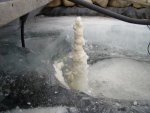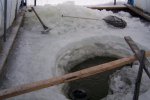MitchM said:
Thanks Dave. Is that your friend in Ft. Saint John? They get pretty extreme temperatures up there. I'm not sure what the frost line is up there, but it's probably around 6 feet.
I have seen a number of koi, (Colleen's, for example) that seem to do well in ~32F waters. I've read where ice crystals forming on the gills of the fish is a real concern, yet we have fish that live long lives in near freezing temperatures.
I'm also thinking of that koi keeper in Norway that imported fish from Japan that did not survive. They don't get extreme temperatures there but the imported fish did not survive.
I'm going to try to find out where our local koi are raised next time I'm in town.
Yeah, there are just too many folk, such as Colleen and others, I have read about that have had koi in near absolute freezing water temperatures and never had a problem.
With a temperature range between -11*F (24*C) and -65.2*F (-54*C), I would imagine the frost line is insanely deep and ice accumulation on the surface would become quite thick. Also, with those low temperatures, it sounds like the region's Winters would be quite long. So, with long winter and thick ice cover with zero holes, I can see problems coming already due to poor pond management.
The theory of the "ice crystals forming on the gills" sounds slightly more reasonable of killing fish except I've never heard of this happening since ice crystals are lighter than water so they would accumulate at the surface. Also, if the fish were at the pond's bottom, then water above freezing would melt those crystals.
All I could find about "burning gills" is it being related to chemical dips, high ammonia, extremely high nitrites, or a pH crash.
CO2 is also heavier than water. So, if the water is not properly circulating, then there can be a thin layer of CO2 accumulation at the bottom. I am told fish generally are aware of these CO2 layers so they'll try to swim above it. Unfortunately, the warmest water is at the bottom on the pond. Also, these CO2 layers can create a pH crash if there is low alkalainity. pH = pKa + log([carbonate]/[CO2 dissolved in water])CO2 and carbonates don't have the same type of relationship as acids have versus carbonates. So, there could be a chance where the fish dips into this CO2 layer where the pH is noticeably lower. Once spring comes around and significant aeration is turned on, then this could cause serious problems if there was a noticeable CO2 layer allowed to accumulate at the bottom.
Fish through respiration and algaes and other biological organisms continue to release CO2 during cold temperatures in water at very low rates. So, in a
very long winter without proper circulation and iced over pond lacking holes, I can see this causing serious problems to the fish.
It would be an interesting to read the article that supports the theory of cold water burning gills and the processes that allow it to happen.




